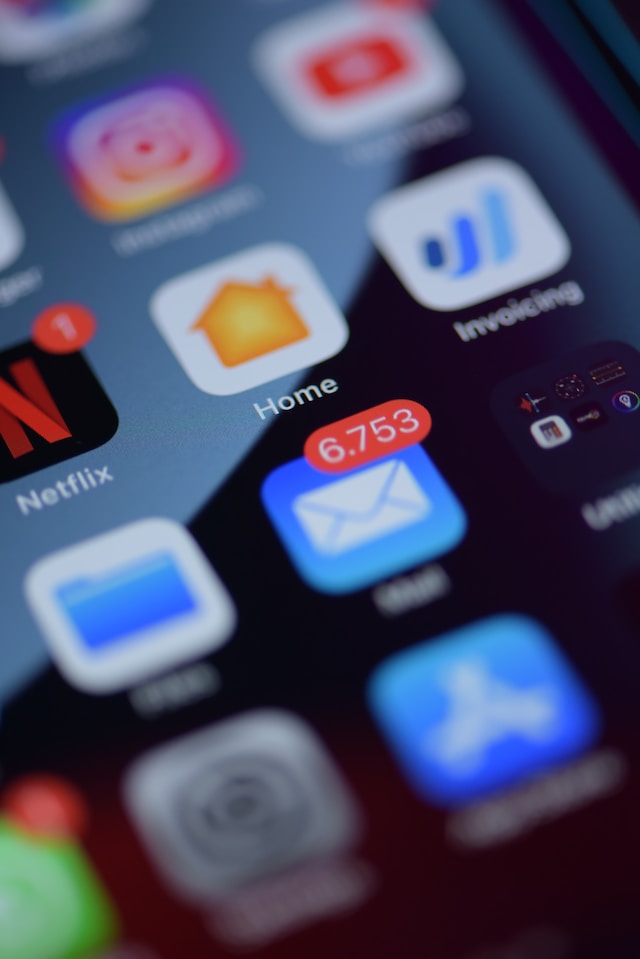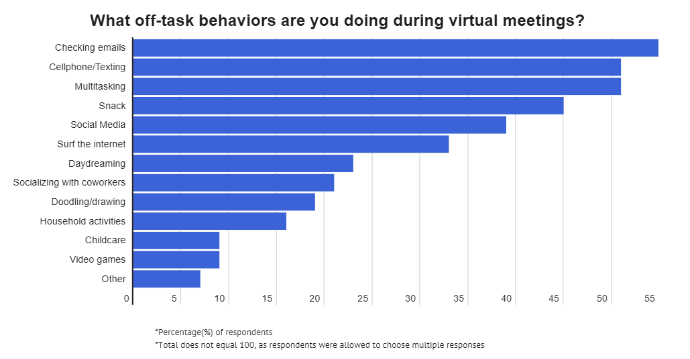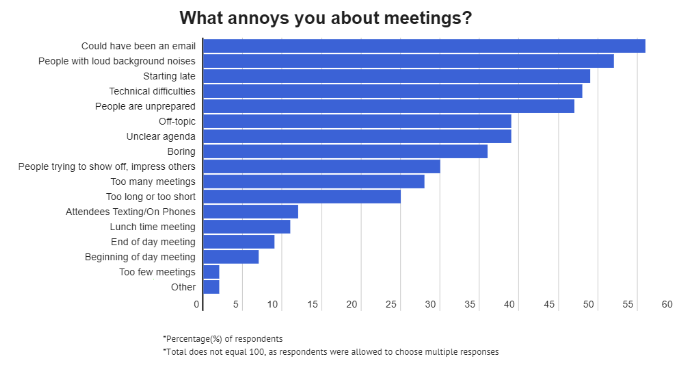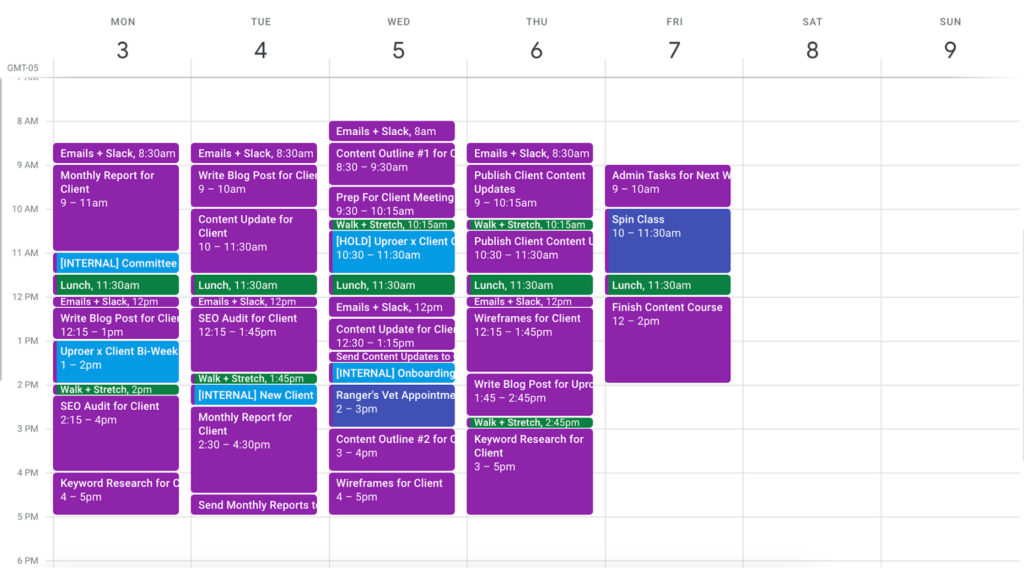Table of Contents
You’ve been in the meetings that should have been an email. You have seen (and sent) the memes laughing at the absurdity, while simultaneously sighing in frustration. We’ve all been there. But it doesn’t need to stay that way.
In this article, we will talk about what meeting fatigue is and why we recommend limiting meetings when possible to promote a positive work environment.

Image from Brian Tromp
What is Meeting Fatigue and Why Are People Talking About It?
While meetings often serve as a valuable tool for collaboration and communication amongst team members, excessive or unproductive meetings can lead to a feeling of dread and exhaustion.
This has become so common that there is now a word for it – meeting fatigue. This phenomenon has gained significant attention, especially as remote meetings have become standard practice for both local and remote employees. It happens with in-person meetings, too.
Filling employees’ calendars with meetings means less work time, dwindling engagement, and frankly, more stress. With remote workers, add in the hours spent staring at a computer screen and it’s unsurprising that employees get frustrated (and get a headache).
An Increase in Meetings Means Less Work Time
Meeting fatigue occurs when people spend a considerable portion of their workday attending meetings, leaving them with limited time to complete their actual tasks and responsibilities.
According to a study by Zippia, an online career resource, the average employee spends around 31 hours per month in unproductive meetings, and that number increases for remote workers.
Do the math, and that’s almost 20% of your hours across a given month, or almost a whole work day per week. This can result in two productivity problems:
1. Employees working beyond contracted hours, which will more often than not lead to employee satisfaction plummeting.
2. Employees not completing work on time, which will definitely lead to internal frustration in-house, or client frustration if you work in an agency or freelance setting.
It’s no surprise that having an excess in meetings directly affects productivity and work efficiency, and employees and managers alike feel the frustration of not having enough time in the day. Add multiple people into the equation, and the time wasted in attempts to match the availability of multiple participants only contributes to this exhausting system.
Zoom Fatigue's Lasting Effect on Remote Workers
Over the past few years, the prevalence of remote work has skyrocketed. With virtual meetings often becoming the norm, meeting fatigue has subsequently amplified. Video platforms like Zoom and Teams have become invaluable tools for remote collaboration, but they also come with their own set of challenges, including what is commonly known as "Zoom fatigue."
Many remote workers find themselves spending hours on end attending back-to-back virtual meetings, often without breaks or time for personal connection. Combined with staring at a screen, it’s draining just to think about.
Not only that, people are often not focused during these meetings. Zippia also found that 55% of employees are multitasking in at least 41% of their meetings. This number only goes up as the meeting length gets longer, and it emphasizes how many meetings are either unproductive, or have attendees that don't actually need to be there.

Image from Zippia
A resource from MIT Sloan shared that virtual meetings are often more mentally taxing than in-person meetings due to the increased effort required to process non-verbal cues and maintain engagement. With a lack of physical presence and an increased difficulty in establishing genuine personal connections with colleagues, these issues are further exacerbated.
As remote work continues to be a prevalent work model, whether hybrid or full-time, the well-being and productivity of remote workers is going to continue to be impacted unless there is a change to how companies communicate and collaborate with each other.
Why We Recommend Limiting Meetings When Possible
At Uproer, we have recognized the negative impact of meeting fatigue on our employees' well-being and productivity. From that, we have made a conscious decision to limit the number of meetings within our company.
By adopting this approach, we are able to foster a work environment that respects individuals' time and maximizes their productivity. Here’s why we do that.
Respect Other Peoples' Time
Ultimately, reducing meeting fatigue means respecting other people's time. Meetings should only be scheduled when necessary for effective communication and collaboration. It is essential to evaluate whether a meeting is the most efficient way to address a particular issue or if alternative forms of communication, such as emails or Slack messages, would suffice.
That being said, if an email is going to take longer to write then it would to hop on a quick call, schedule the meeting. When you do need to schedule meetings, be mindful of the duration of meetings, ensuring they are scheduled for the amount of time needed to complete the task, and only invite who needs to be there.
Promote Productivity and Use Time Effectively
Unsurprisingly, reducing meetings ultimately encourages productivity by providing employees with more uninterrupted work time. When you do need to schedule a meeting, it is crucial to have a clear understanding of the meeting's purpose and objectives. This includes coming prepared with the necessary information and materials, ensuring that discussions stay focused and on track.
By leveraging technology and collaboration tools, such as shared documents and project management platforms, participants can streamline the collaborative process, making non-negotiable meeting time count. At Uproer, we use a variety of tools to accomplish productivity:
- Google Calendar — We use an open-calendar policy to share our schedules internally, and also leverage our calendars to block off "heads down" work time to increase productivity and plan around necessary meetings.
- Asana — We use Asana to assign tasks, both to ourselves and our co-workers. This helps maintain an open line of communication on due dates and the progression of a project, reducing the need for other forms of communication (including meetings!).
- Kipwise — We are starting to use Kipwise as a central hub for files and other internal information. Gone are the days of digging through Google Drive and bothering other co-workers to send you files you just can't find!
Improve Employee and Client Satisfaction
Reducing meeting fatigue not only benefits employees, it also improves client satisfaction. By optimizing meeting practices, your clients or other stakeholders feel that their time is valued and not wasted on unproductive discussions. In turn, client relationships are enhanced, and you have an easy-win to foster a positive reputation for your company and relationship with your clients.
According to data from Zippia, 45% of employees feel overwhelmed by the amount of meetings they are required to attend, which in turn affects overall employee satisfaction. By prioritizing efficient and purpose-driven meetings, you can create an environment where both employees and clients feel their time is respected and valued.

Image from Zippia
Work Practices To Help Lessen Meeting Fatigue
In order to align with our values and practice what we preach, our team at Uproer has implemented several work practices aimed at lessening meeting fatigue and promoting a productive work environment. These practices ensure that meetings are purposeful, well-organized, and limited to only when necessary. Here’s how we do that.
Set Up Recurring Meetings with Clients
To streamline communication and minimize scheduling difficulties, we establish recurring bi-weekly meetings with our clients. By doing so, we eliminate the need for frequent back-and-forth scheduling and provide a consistent framework for collaboration. No longer are the days of constantly having to fight against cross-company scheduling. This approach also allows us to build our schedule around these meetings, maximizing efficiency and reducing the time spent on unnecessary and time-consuming administrative tasks.
Have a Meeting Agenda Ready Before the Meeting
Preparing a meeting agenda and sharing it with all meeting participants well in advance is essential for efficient meetings. Participants from both sides, internal and client, are able to add notes and questions so nothing is forgotten. A well-structured agenda outlines the topics to be discussed, provides relevant background information, and sets clear objectives for the meeting, so that you can spend your meeting time discussing what really matters. By doing this, all participants can come prepared, ensuring that the discussion stays focused and productive.
Be Mindful about Who is Included on a Meeting Invite
When scheduling a meeting, it is crucial to carefully consider who truly needs to be there. Including unnecessary participants can prolong the meeting and hinder productivity (not to mention wastes money, if you are on an hourly basis). That being said, it is equally important to have a communication plan in place to keep relevant stakeholders informed and involved, even if they are not required to attend meetings. This way, vital information can be shared without having people attend meetings that they don’t really need to be attending.
Leverage Open Calendars and Time Blocking
To effectively manage meeting schedules and avoid overwhelming individuals with back-to-back meetings, we also utilize open calendars and time blocking. By making calendars visible to colleagues, our internal team can be aware of others' availability before scheduling a new meeting. Additionally, proactively scheduling regular breaks during the day helps prevent meeting overload and allows us to recharge, without compromising productivity.

At Uproer, we have also implemented an Offline Fridays policy. This initiative encourages employees to catch-up on Fridays, whether that be with some heads down work to wrap up projects without distractions, or completely logging off to spend time recharging out of office. Using this framework creates a space for personal flexibility, and promotes productivity and self-accountability earlier in the week. Our system of a 4-day work week has proven successful in reducing meeting fatigue and increasing overall job satisfaction.
Be Realistic about Communication Needs
Determining the most appropriate mode of communication is essential to combatting meeting fatigue. While meetings are valuable for real-time discussions and collaborative problem-solving, certain tasks are really meant for email or Slack conversations. Evaluating the urgency and complexity of the message can help determine whether a meeting is truly necessary, as well as the amount of time it would take to effectively communicate needs via messaging platforms.
Here at Uproer, we utilize a Slack vs. Email Policy so we are not flooding peoples' inboxes, and can help reduce distractions during the workday. Basically, if it's going to take a significant amount of time for the recipient to review the message, send it in an email. If it's a quick message, send it in Slack! Whether it's a meeting or a message, we are intentional with our communication methods to ensure we are respecting everyone's time, including our own.
Set Employees Up for Success by Limiting Work Meetings
Meeting fatigue is an incredibly common issue affecting the productivity and well-being of both remote and in-person employees at companies in all industries and of all sizes. By implementing strategies to limit and optimize meetings, you can make sure you’re promoting a more productive and satisfying work environment.
Respecting people’s time can go a long way in boosting employee happiness (not to mention promoting a healthy work-life balance), so be intentional with your time, and your colleagues and client's time, too. Want to learn more about how we work here at Uproer? Book a call with us today!

